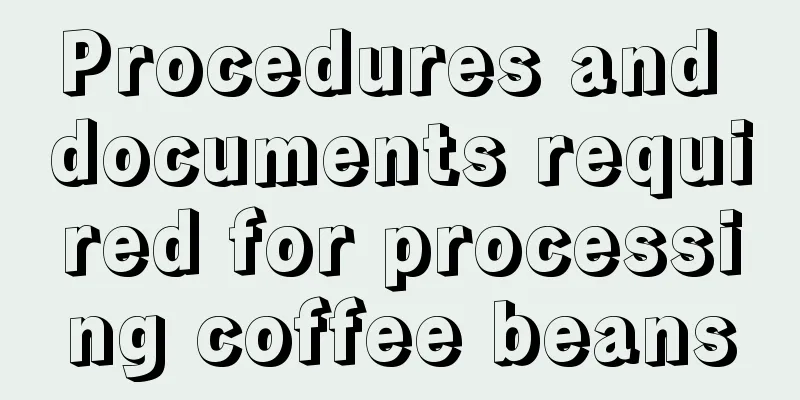Procedures and documents required for processing coffee beans

Procedures and documents required for processing coffee beansProcessing coffee beans is a complex process that requires compliance with a series of formalities and obtaining relevant certificates. This article will detail the procedures and certificates required for processing coffee beans according to the requirements. 1. Raw material procurementBefore you can start processing coffee beans, you first need to source quality raw materials. This includes buying fresh coffee cherries or green, unprocessed coffee beans from farms or suppliers. In order to ensure the quality and legality of raw materials, you need to sign a contract with the supplier and keep relevant documents for inspection. In addition, in some countries or regions, you may also need to apply for an import license or other import documents. 2. Health PermitIn the process of food processing, hygiene and safety are of vital importance. Therefore, before starting any form of food processing, you must obtain a health permit issued by the local health department. Applying for a health permit usually involves submitting an application form, providing company registration information, facility floor plans and other documents, and accepting an on-site inspection by the health department. Only after obtaining a health permit can you officially start coffee bean processing. 3. Factory RegistrationBefore processing coffee beans, you need to register your factory as a legal food processing company. This involves submitting an application to the local government or relevant agency and providing information such as company registration documents and business scope. Typically, the government will review the application and send personnel to conduct on-site inspections to ensure that the facility meets the requirements. Once the review is passed and the registration certificate is obtained, you can legally start a coffee bean processing business. 4. Environmental Impact AssessmentCoffee bean processing may have some impact on the environment. Therefore, in some countries or regions, you may need to conduct an Environmental Impact Assessment (EIA) and obtain relevant permits. EIA is a systematic process for assessing and managing the potential environmental impacts of a project. It usually includes steps such as submitting an EIA report, accepting public comments and participation. Only after passing the EIA and obtaining a license can you legally process coffee beans. 5. Quality CertificationTo ensure the quality and traceability of your coffee beans, you may want to consider obtaining relevant quality certifications, which are usually issued by third-party organizations, such as the Q-Grader certification from the International Coffee Organization (ICO). Obtaining quality certification can improve product competitiveness and convey trust and reliability to consumers. Applying for quality certification requires submitting relevant documents and undergoing on-site assessment. Once you pass the assessment and obtain certification, you can mark the corresponding mark on your product. 6. Export PermitIf you plan to export processed coffee beans to other countries or regions, you may need to apply for an export license. Export license requirements vary from country to country and usually involve submitting an application, providing a product inspection report, and paying relevant fees. In addition, there may be specific requirements to be met in certain destination countries, such as compliance with organic farming standards or specific food safety standards, etc. Therefore, before exporting, make sure you understand the relevant regulations and requirements of your target market. SummarizeProcessing coffee beans requires a series of procedures and relevant certificates. This includes raw material procurement, health permits, factory registration, environmental impact assessments, quality certification and export permits. Each step is an important link to ensure product quality and legality, and must be strictly followed and operated according to the specific requirements of different countries or regions. By processing coffee beans legally and obtaining the appropriate certification, you can ensure that your products meet standards and gain a competitive advantage in the market. At the same time, this will also help build trust and increase consumer recognition of your brand. |
<<: Japanese coffee bean sales center, find your unique coffee experience
>>: The unique way to create coffee bean flavor
Recommend
Kudi Coffee: New product on the market, unique aroma, amazing taste buds!
introduction Recently, the highly anticipated new...
Making flower fertilizer from coffee grounds: a simple and easy-to-learn flower-growing secret
How to make coffee grounds fertilizer Growing flo...
The wonderful world of coffee, explore the various types of coffee
The wonderful world of iced Americano coffee is f...
Coffee and children, the health truth behind cat poop coffee
There is a controversy behind Kopi Luwak regardin...
Coffee bean brand recommendations: best taste and aroma, a look at the advantages of various brands
Coffee bean brand recommendations: best taste and...
Coffee beans production and processing process and characteristics
Coffee beans are a widely popular beverage ingred...
Top Coffee Bean Brands: Choosing the Best Coffee Bean Supplier
Top quality coffee bean brands When choosing the ...
Freshly ground coffee, enjoy the aroma
Freshly ground coffee, enjoy the aroma Coffee is ...
Coffee beans with unique flavors and different tastes
The unique flavor of coffee beans Coffee is a pop...
The impact of regular coffee drinking on your health
Effects of coffee on health Coffee is a widely lo...
Four Cats Cafe, an in-depth analysis of its charm
The charm of Four Cats Coffee lies in its unique ...
Coffee World: Variety of Tastes, Endless Flavors
The origin of coffee Coffee is a plant that origi...
Instant coffee, what exactly are we drinking?
As a child who was fed strong tea by my irresponsi...
Explore the best coffee beans and enjoy the unique choice with rich taste!
Explore the best coffee beans and enjoy the uniqu...
Alicafe Coffee: Taste the Purest Coffee and Awaken Your Taste Buds
Taste pure and awaken your taste buds Coffee is a...









